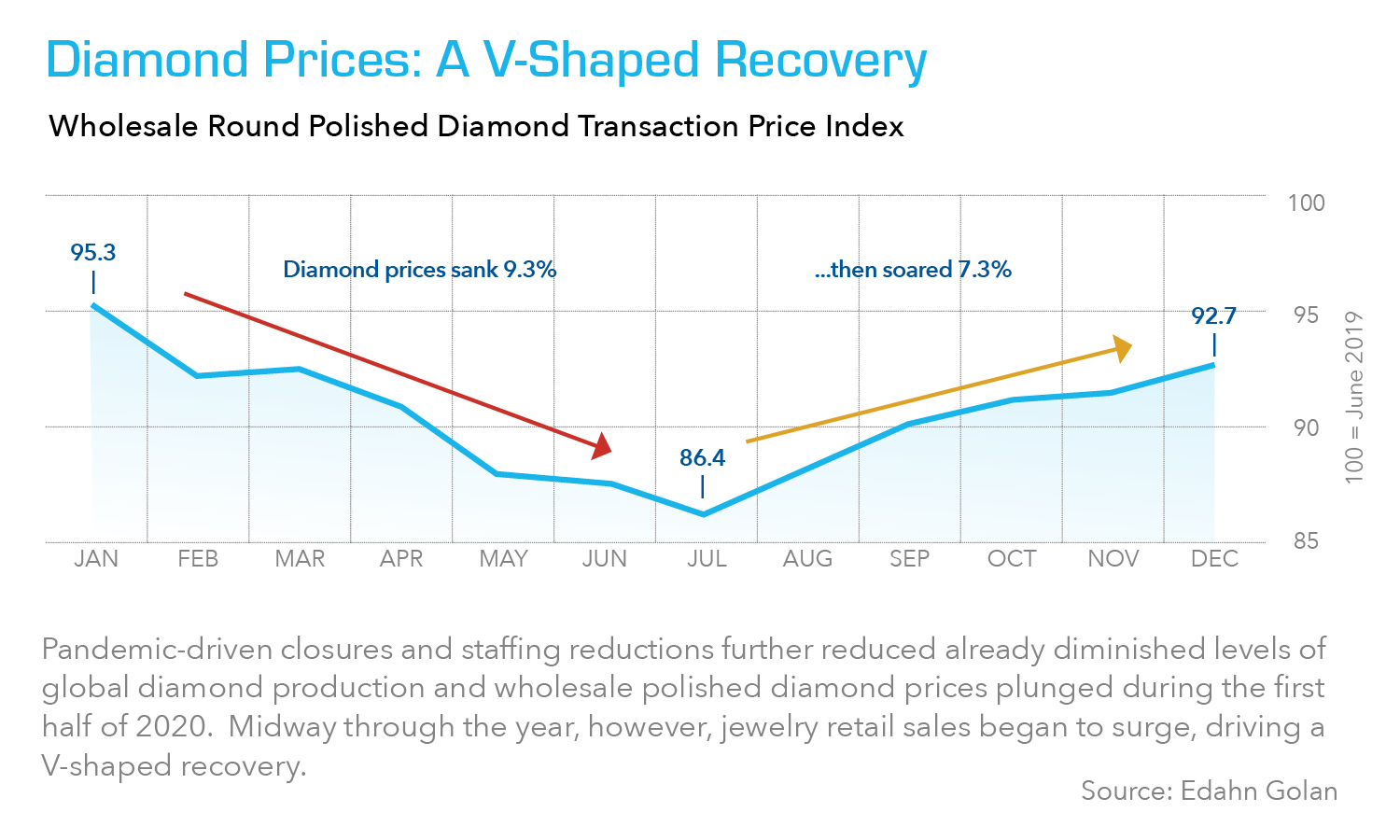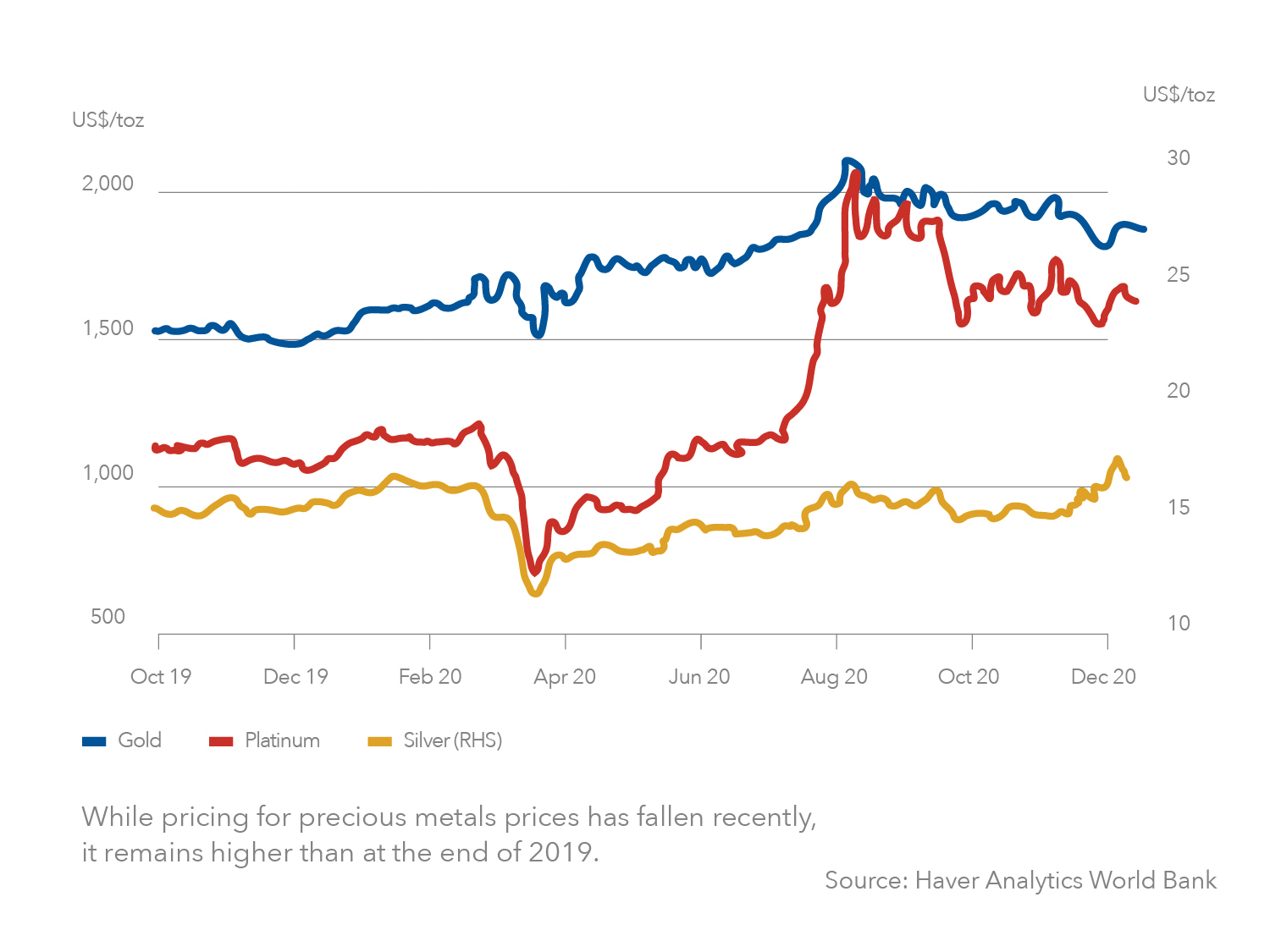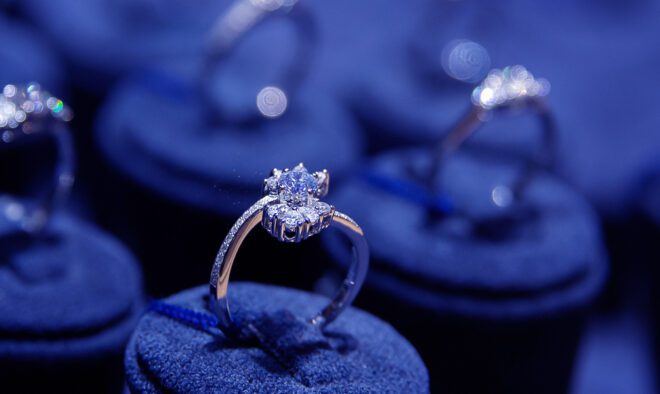Jewelry Trends and Key Considerations for the Asset-Based Financing Professional

In this article, we take a look at the state of the Jewelry Industry one year into the global pandemic and provide a general guide to lenders for effectively evaluating both prospective borrowers and existing portfolio accounts.
In 2019, prior to the pandemic, both the polished and rough diamond markets were in an underperforming state, driven by lower end consumer demand that contributed to a glut of supply chain inventory. In the first half of 2020, with the impact of COVID-19 being absorbed into the marketplace and sales slowing, both low- and high-quality stones were negatively impacted, with the greatest effect seen on larger sizes. As Polished stone demand decreased, production of cutting was shut down. This development had a notable impact on supply, most significantly from India. Significant sales declines experienced by mining companies in 2019 continued into the first half of 2020. Sight deferrals were granted, followed by price concessions from the mining companies. Large mining companies DeBeers and Alrosa announced price concessions on Rough stones, with industry news articles indicating price drops in the 6% to 8% range (primarily for slower moving stones) for the August 2020 sight for DeBeers.
DeBeers has more recently discontinued its policy of allowing sightholders to defer 100% of their Rough purchase allocations to later in the year, which has been in place since the March/April 2020 trading session. While this policy has been discontinued, there will still be some deferral opportunities for sightholders, but these are expected to be in the 20% to 30% range for each sightholder’s Rough allotment.
The shortage in supply, coupled with wholesalers holding onto product, has created price stability for Polished stones in more recent months. As the economy begins to recover and retail stores reopen, we are seeing both demand and supply increasing. It is also noteworthy that the decline in Rough prices affords manufactures and wholesalers margin opportunity pertaining to the sale of Polished stones, provided they maintain their price points and do not resort to price cuts as a means of generating cash. According to the Diamond Prices Index™, diamond prices moved higher by an average of 1.1% in February 2021, with the average price per carat of all diamonds in its database at $10,631.20 as compared to $10,408.98 a month prior.

By necessity during the pandemic, consumers have shifted their spending habits away from leisure activities such as travel, entertainment, and dining. This has benefitted hard goods and discretionary items such as jewelry, with the sector seeing increased purchasing based on spending by those consumers falling in the upward leg of the “K”-shaped recovery and to some degree from continuing government stimulus incentives. According to data from marketing company Statista, jewelry was the 3rd ranking option for Valentine’s Day gifting in 2021 behind only candy and flowers. Last year it placed a distant 11th on the same list. Additionally, while the number of weddings put on hold due to social distancing requirements has continued to increase over the many months of COVID-19, the number of engagements has actually increased over normal levels, which has benefitted jewelers’ bridal sales activity. Not surprisingly, jewelers with operations or sales to customers located in tourist destinations, on cruise ships, and at casinos have notably underperformed due to COVID-19 restrictions.
From a precious metals perspective, during periods of financial duress for the economy, gold has been viewed as a safe haven investment choice and has experienced a general increase in value. A change in gold pricing influences product costs, retail price points, melt value, and at times may also influence gold content in a piece.

While there has been a meaningful global shift towards ecommerce driven by COVID, the jewelry industry historically has been predominately geared towards the in-store purchase experience. Although large jewelry industry e-tailers have been at the forefront of this change to digital jewelry transactions, the transition for traditional brick and mortar jewelers has been much slower. In large part, this has been due to the complexities and costs associated with showcasing this type of product effectively via flattering 360-degree visualizations on a website. As a result, to-date, many jewelry retailers have not been able to fully implement the level of imaging required to appeal to buyers and drive sales with a high success rate directly from their own sites.
Recommended Due Diligence For Lenders Working With Jewelry Industry Borrowers
When Hilco approaches the process of establishing a valuation for a business in the jewelry industry, we conduct in-depth diligence which provides the data and insights that enable us to establish Net Orderly Liquidation Value (NOLV). We consistently find that when the lenders we work with are highly knowledgeable about these businesses, it serves their own ongoing interests across the board. Additionally, the quality of the initial inputs we receive from these knowledgeable lenders helps us to provide a more accurate initial estimated range and launching off point for determining the NOLV via our appraisal process. With this in mind, particularly during the course of the ongoing pandemic, we highly encourage lenders to make sure they are “in-the-know” regarding each of the below operational components of their jewelry portfolio businesses:
Key Considerations That Can Greatly Impact The NOLV Recovery Range
Memo Exposure
During this period in particular, Hilco recommends that lenders have a general understanding of their borrower’s memo exposure. Key areas to investigate include memo out inventory levels, asset versus memo mix, the timeframe memo is offsite (short versus long term), who the product is with (customer, supplier, artisan, grading agency, sales representative) where it is physically located (Domestic, China/Hong Kong, Vietnam, etc.), and if there are Uniform Commercial Code (UCC) filings in place.
Memo adds inherent risk in a liquidation setting, including recall related challenges such as elapsed time to return, freight costs, and potential shrink. Recalled memo may also consist of less desirable pieces. In our valuation work, Hilco considers not only the composition of the memo inventory, but also whether or not it is complementary to the on-hand asset goods, as this will impact the sales capacity considerations in the appraisal. Separately, from an ongoing collateral monitoring perspective, we also advise that Lenders monitor the timeliness of a retail customer recording a memo sale and subsequent payment to vendor.
Turn and Aging
Jewelry is generally slow turn, approximately once per-year on average. Often times, one of a kind, marquee pieces remain on hand for multiple years without being sold. Certain items out on memo can also be very slow turn. While aging impacts recovery rates to a degree, what also needs to be thoroughly understood is the potential for repurposing slow-moving items. This includes considerations such as: 1) The intrinsic value of the item itself (the stone/precious metal component of the piece) and 2) Whether the piece can be redesigned and given new life without a significant loss to overall cost value. When a higher than industry average turn rate is noted, the specific factors influencing this observed rate – such as Just in Time (JIT) sales or memo sales being included in the asset turn calculation – should be identified and clearly understood by the lender.
Expenses
Slow product turn generally generates an extended sale term in an appraisal. The longer term coupled with payroll/commissions and overall occupancy/product display related expenses increase the expense burden for retail jewelry accounts. Conversely, for non-retail jewelry, the high per-unit inventory cost value and small physical per-unit size often present favorable expense absorption opportunities in an appraisal liquidation expense structure. Thousands or even millions of dollars in inventory can be efficiently stored in a single standard vault at a jewelry distributor as compared to the costly display needs of a retail operation. These distinctions should be clearly identified and understood.
Trends
The changing nature of jewelry fashion adds complexity to the product assortment. The popularity and desirability of designers, including national and international brands, and even types of product such as: white gold, yellow gold, rose gold, diamond shapes, and ring styles such as Halo and cluster are all subject to the fickle nature of changing consumer preferences. From a valuation perspective, it is critical for lenders to understand what is considered as historically “timeless” versus “current” in demand fashion.
Seasonality
Jewelry sales demand is highly seasonal in nature, particularly for retail accounts. While the fourth quarter holiday season is a material driver of annual sales, additional holidays including Valentine’s Day, Mother’s Day/Father’s Day, Graduation and Wedding seasons, all drive increased demand. Accordingly, it is important that the appraisal and construction of the lender’s credit facility consider this larger picture. We segment appraisals into low and high volume selling periods or monthly appraisals and also advise lenders to segregate their advance rates (how much money they’re lending) based on seasonality considerations.
Financing
The elevated price point of select jewelry pieces has made financing commonplace in the retail setting over the past many years. In a liquidation scenario, we have found that the ability to offer financing may not always be possible. To make an informed decision as to whether a consumer is still likely to purchase particular items using other payment methods in a liquidation scenario where financing cannot be offered, it is essential for a lender to possess an understanding of the historical payment terms offered to a business’s consumers, the nature of the financing (no interest, in house versus third party credit card), and the overall concentration of financed sales in comparison to total sales.
Wholesale
It is common in the jewelry industry for manufacturer/distributors to be both a customer as well as a vendor to the various companies with which they do business. The marketplace for jewelry is highly diverse, particularly for commodity goods such as diamonds and precious metals. In addition to brokers in the U.S., international markets such as China, Israel, and India all present highly viable liquidation opportunities. Additionally, high-end jewelry pieces also may benefit from auction house sales potential. Precious metals also have a tangible melt value which should be used to create a “floor” for the gross recoveries in an appraisal. Beyond selling into a retailer’s usual channels, there are a number of other channels that product can be sold into. These may include going back to vendors (assuming there isn’t an outstanding payable offset), selling to domestic or international brokers, or – for very high-end items – auction houses such as Christie’s or Sotheby’s. It is essential for a lender to understand these options based on the fact that there is an inherent value of goods in Jewelry based on market conditions that often presents options that don’t necessarily exist in other asset classes.
Costing
To properly determine exposure, inventory costing should be clearly understood including the impact related to changing commodity costs and how exchanged products such as estate jewelry at a retailer or memo swaps for a wholesale/manufacturer are costed by the business. Here, it is essential for the lender to know the basis used for determining proper value and how the business benchmarks these one-off items that aren’t typically part of its inventory but that, for example, it is now seeing more of during the pandemic or that it sees during periods when gold or other precious metals pricing is high.
Assortment
By carrying certain select brands and designer merchandise, a Jeweler can add prestige to its retail store. This merchandise not only attracts affluent customers but can also provide the retailer with access to other brands seeking to be in high-end stores. While carrying these brands often benefits top line sales, the associated higher average tickets also frequently come at the expense of margin. For these and other reasons, the full scope of product offerings and any changes in existing relationships (e.g., recent loss of a select brand that could result in the loss of others) with key vendors should be closely monitored by the lender as these have the potential to impact financial reporting results and appraised value. Importantly, a business’s sales mix will influence overall margin as well. Sales of loose stones, for example, have a below average margin as compared to stones sold in settings. The margin on rough stones is less than the margin for polished stones.
Licensed Inventory
While licensed inventory concentration is generally low at most jewelry companies, some of the most common licensed product includes collegiate merchandise and Disney branded product. When these are part of the product mix, regardless of the percentage, we recommend that the associated agreements and sale restrictions be thoroughly reviewed by the lender to ensure an understanding of any inherent risk associated with those product lines.
Fraud
Perhaps more than ever before, the jewelry industry is acutely aware of the potential for fraud, particularly in regard to lab grown stones being passed off as mined diamonds. This is something the industry is working hard to prevent. As a result, technology such as the DRC Techno J-Secure is now being more widely utilized and should be encouraged to detect items that are lab grown versus mined. Procedures for inventory cycle counts to protect against shrink as well as vault storage practices to protect against theft should also be understood and closely monitored. Additionally, a business’s ability to match the serialization on a diamond to its grading certificate on hand should also be tested via a random audit process as part of a lender field exam at regular intervals. Hilco regularly conducts these match tests as part of the many field exams we perform each year for our clients with jewelry industry portfolio exposure.
Jewelry Industry Terminology Primer
As is the case with many industries, jewelers speak their own language. This terminology primer can help lenders gain a better understanding of important terms that are likely to be discussed by borrowers and used in written communication and reporting by industry participants.
Asset versus Memo
Asset (owned) and Memo (consignment) inventory. Memo can be further broken down into Memo-In and Memo-Out. Memo-In incudes goods on site at a borrower that are owned by a vendor or may be end consumer purchased items on hand for repair. Memo-Out can be both short and long term in nature. Examples of short term include inventory with sales representatives, inventory at third party grading agencies, and inventory temporarily with end consumers. Long term memo out includes inventory with retail customers.
Carat versus Karat
A “carat” is a unit of weight used to measure the size of a gemstone such as a diamond. “Karat” is a measurement indicating the proportion of gold in an alloy out of 24 parts, (i.e. 18K gold is 18/24 parts gold).
Diamond Grading (4 C’s)
Color: For non-fancy colored diamonds, a diamond is graded on how close it is to colorless. The scale is “D”-“Z” with D being colorless.
Clarity: The Clarity grade represents the inclusions/blemishes on a stone. The range includes: Flawless (FL), Internally Flawless (IF), Very Very Slightly Included (VVS1 and VVS2), Very Slightly Included (VS1 and VS2), Slightly Included (SI1 and SI2), Included (I1 I2, and I3).
Cut: Proportions are key to how a diamond interacts with light, which leads to how much the diamond sparkles. This is referred to as cut, which ranges from Poor/Fair, Good, Very Good, and Excellent.
Carat Weight: Carat refers to the size of a stone. The larger the stone, the rarer it is. Therefore, a one carat diamond is worth more than two half carat stones (all other characteristics being equal).
DTC
The Diamond Trading Company (DTC) is the rough diamond sales and distribution arm of the De Beers Family of Companies
Estate Jewelry
Refers to pre-owned jewelry and based on age may be also termed vintage or antique.
Fancy color
Unlike the standard diamond color range where grading is based on the absence of color, fancy colored diamonds have some form of color to them. More common colorings includes shades of yellow and brown. Colors including pinks, blues, and greens are extremely rare and valuable.
Fancy shape
Refers to a diamond shape other than a round stone. There is generally additional margin opportunity for sellers of fancy shape diamonds as these are not as commoditized as round brilliant stones.
Gemologist
A qualified individual who is able to identify, grade, and appraise gemstones. A gemologist appraisal differs from an inventory appraisal of a jeweler which represents an orderly wind down of the business net of expected sale expenses.
Grading Certificate
Larger diamonds are often graded by third party grading agencies. Most commonly used agencies include Gemological Institute of America (GIA) and American Gem Society (AGS).
Jewelry Artisan
Hand crafted jewelry manufacturer.
Melee
Small diamonds less than 1/5 of a carat. These stones are generally not sold individually due to their low individual value. A single piece of jewelry may be comprised of multiple melee stones.
Metal Findings
Include items such as clasps, headpins, eyepins, crimps, bails, and earwires. In the absence of a conversion in a liquidation, these types of items (i.e., the backing of an earring) generally recover at melt value and may be deemed ineligible.
Mined versus Lab Grown (Synthetic)
A diamond is formed in an environment that includes carbon, pressure, heat, and time. Mined diamonds are extracted from deep in the earth and are millions of years old. Technology has allowed companies to replicate this process in a lab setting. Man-made stones are commonly referred to as either lab grown or synthetic stones. Unlike cubic zirconia and moissanite, a lab grown stone is an actual diamond. Lab grown stones currently retail for a fraction of the cost (30-40% less) of a mined diamond. Lab grown and mined diamonds are very difficult to tell apart, even to a trained eye. The jewelry industry has invested in technology to determine whether loose and set stones are mined or lab grown. The J-Secure machine is a popular machine designed for lab grown diamond detection.
Parcels
Collections of loose stones, generally similar in characteristics, are called parcels. These parcels are stored in folded pieces of paper.
Points
This quantifies the weight (size) of a diamond. This terminology is typically used for small stones. 100 points = 1 carat.
Ring Components
Include items such as semi-mounts, settings, and ring heads. In the absence of a conversion in a liquidation, these types of items generally recover at melt value and may be deemed ineligible.
Rough versus Polished
Rough diamonds are bought and sold on a wholesale basis and represent the state a diamond is in prior to it being cut and polished. What an end consumer views in a retail store are polished stones (regardless of whether they are mounted in a ring or loose).
Semi-Precious Gemstones
Diamonds, rubies, sapphires, and emeralds are considered precious gemstones. All remaining gemstones, over 100 in total, are considered semi-precious.
Sightholder
DeBeers sells rough stones direct to registered sightholders. Diamond manufactures who are not sightholders can still purchase rough stones mined by DeBeers, however this is completed on the wholesale market.
Trunk Show
Jewelry manufacturers and distributors will bring product on site to retailers in order to showcase to consumers.
A list of external sources used in compiling portions of this jewelry industry primer can be obtained from Hilco upon request.
Hilco Valuation Services
At Hilco, we are currently engaged in multiple jewelry company valuations and are having informative conversations with our industry contacts and partners on a regular basis. Whether you are working with a prospective jewelry borrower or have current industry exposure within your portfolio, the more you understand about those businesses the better. This is particularly true in the current climate. As information on a borrower is gathered, we recommend that lenders share these details with the Hilco or the selected appraiser prior to an official appraisal engagement. Doing so will facilitate a more efficient and effective process in areas including initial recovery guidance and general report setup recommendations. To learn more, we encourage you to reach out to our Jewelry Team at Hilco Valuation Services today. We are here to help!




